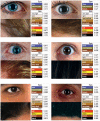The Use of Forensic DNA Phenotyping in Predicting Appearance and Biogeographic Ancestry
- PMID: 31941575
- PMCID: PMC6976916
- DOI: 10.3238/arztebl.2019.0873
The Use of Forensic DNA Phenotyping in Predicting Appearance and Biogeographic Ancestry
Abstract
Background: Persons whose identifying DNA profile (STR profile) is not yet known to the ingvestigating authorities cannot be identified by standard forensic DNA analysis (STR profiling) as it is now practiced. In view of the current public debate, particularly in Germany, on the legalization of so-called forensic DNA phenotyping, we present its scientific basis, societal aspects, and forensic applications and describe the analytic techniques that are now available.
Methods: This review is based on pertinent publications that were retrieved by a selective search in PubMed and in public media, and on the authors' own research.
Results: Forensically validated DNA test systems are available for the categorization of eye, hair, and skin color and the inference of continental biogeographic ancestry. As for statistical measures of test accuracy, the AUC (area under the curve) values lie in the range 0.74-0.99 for eye color, 0.64-0.94 for hair color, and 0.72-0.99 for skin color, depending on the predictive model and color category used.The corre- sponding positive predictive values (PPV) are lower. Empirical social-scientific research on forensic DNA phenotyping has shown that preserving privacy and protecting against discrimination are major ethical and regulatory considerations.
Conclusion: All three methods of forensic DNA phenotyping-the predition of exter- nally visible characteristics, biogeographic ancestry, and the estimation of age from crime scene DNA-require a proper regulatory framework and should be used in conjunction with each other. Before forensic DNA phenotyping can be implemented in forensic practice, steps must be taken to minimize the risks of violation of privacy scrimination and to ensure that these methods are used transpar- ently and proportionately.
Figures

Comment in
-
Biogeographic Ancestry Cannot Be Unequivocally Determined.Dtsch Arztebl Int. 2020 Apr 10;117(15):269. doi: 10.3238/arztebl.2020.0269a. Dtsch Arztebl Int. 2020. PMID: 32449892 Free PMC article. No abstract available.
-
In Reply.Dtsch Arztebl Int. 2020 Apr 10;117(15):269-270. doi: 10.3238/arztebl.2020.0269b. Dtsch Arztebl Int. 2020. PMID: 32449893 Free PMC article. No abstract available.
References
-
- Kayser M, de Knijff P. Improving human forensics through advances in genetics, genomics and molecular biology. Nat Rev Genet. 2011;12:179–192. - PubMed
-
- Kayser M. Forensic DNA phenotyping: predicting human appearance from crime scene material for investigative purposes. Forensic Sci Int Genet. 2015;18:33–48. - PubMed
-
- Phillips C. Forensic genetic analysis of bio-geographical ancestry. Forensic Sci Int Genet. 2015;18:49–65. - PubMed
-
- VISAGE Consortium. (2018) The regulatory landscape of forensic DNA phenotyping in Europe. www.visage-h2020.eu/Report_regulatory_landscape_FDP_in_Europe2.pdf (last accessed 15 May 2019)
-
- Caliebe A, Walsh S, Liu F, Kayser M, Krawczak M. Likelihood ratio and posterior odds in forensic genetics: two sides of the same coin. Forensic Sci Int Genet. 2017;28:203–210. - PubMed
Publication types
MeSH terms
Substances
LinkOut - more resources
Full Text Sources
Research Materials

